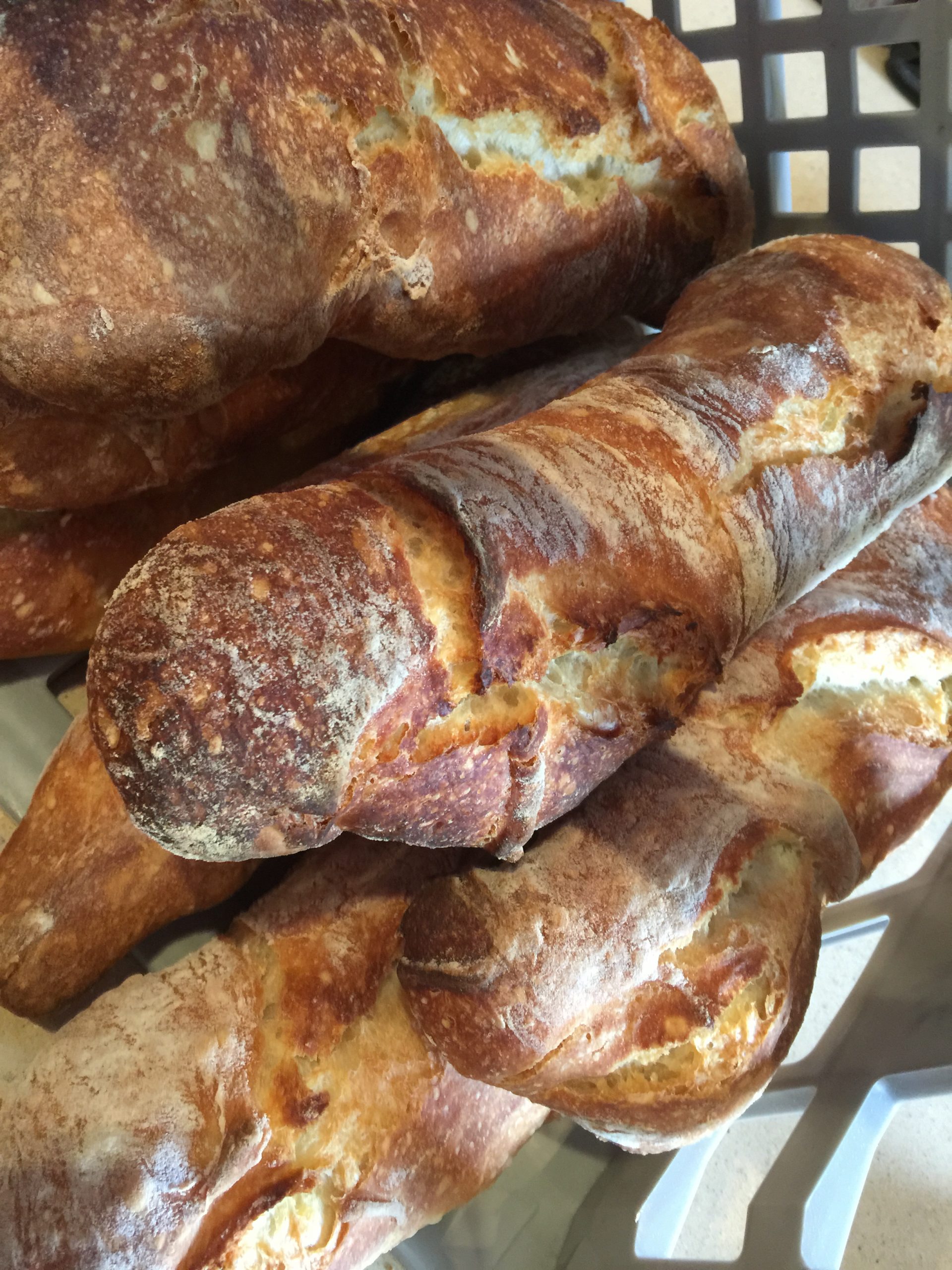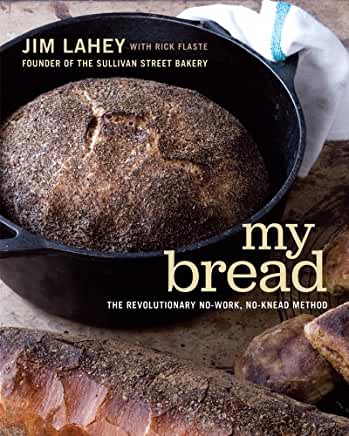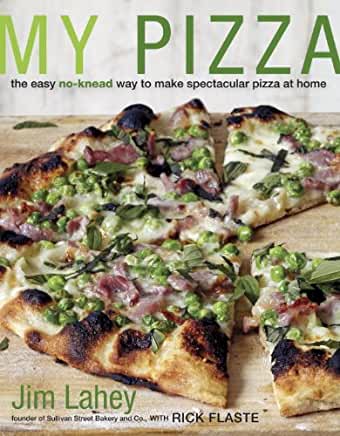
jim lahey
fabulous
no-knead
bread
At least ten years ago a fellow cook keen on recipe sharing, the late Tony Walsh sent me a recipe from New York baker Jim Lahey. Shortly after a number of other friends and colleagues started telling me about this marvellous bread recipe and sending me images of their bread. It became imperative that I should try. It was the start of a long love affair with Jim Lahey’s brilliant recipe writing.
About three years ago when I down sized I had to make some serious and difficult choices about the books I kept. My five editions of Larousse Gatsronomique were my first choice and my second My Bread and My Pizza. They are thumbed over and loved and I have purchased a number of copies of both books, given them away, missed them and purchased them again.
Lahey’s books have been a constant source of enjoyment for me over many years.
Jim Lahey and his most famous Sullivan St Bakery [New York] quickly became entrenched in my own cooking and since then I have shown hundreds of chefs and home cooks how to make his wonderful breads and pizza. Lahey is a superlative recipe writer, recipes that work with infallible technical descriptions.
One of the things that I love about Lahey’s generous recipe writing is that it is as fathomable to the novice yeast baker as it is to the professional.
At the height of COVID19 Sullivan Street Bakery was home delivery or take-home, however, a number of our followers have attended cooking classes with Jim and left rave reviews. So, if you don’t own these books support the generosity of Jim Lahey by buying his books.
It is a fact that all recipes that are used thousands of times have incremental changes. Just alone, in the time since we first started making Jim’s bread, domestic ovens have been vastly improved and it is now possible to bake commercial quality bread at home. So, the recipe below is the version and method I currently use. It has been unaltered for about three years now.
AO FIRST PUBLISHED 15 MAY 2020…UPDATED 11 DECEMBER 2023
Use the links on the covers below to go to details, both books have been available at Imprints Booksellers [Hindley Street, Adelaide] and Dillons [The Parade, Norwood]
makes 4 loaves......or
6 baguettes
750g flour
3g dried yeast [2 x 1/4 teaspoons ever so slightly rounded]
15g fine sea salt
600g filtered water
about 20g additional flour
coarse polenta or semolina
Weigh the flour, yeast and salt into your proving bowl and mix together.
Weigh the water into the bowl and wrk the dough into a shaggy dough. Make sure that all the flour has been incorporated and scrape down the sides. Cover with the lid and prove.
Very lightly flour your work surface. Scrape the dough onto the surface and fold four times [see video 1]. Generously dust the top of the dough with polenta or semolina and cover with the dough bowl. Set a timer for 30 minutes.
Cover your baking sheets with silicon mats or baking paper. Shake more polenta or semolina onto the dough and using a bowl scarper make the dough out into the number of loaves you are going to make.
Working one loaf at a time [see video 2] cut the loaf and coat it with the polenta/semolina. Repeat the process until finished.
turn oven on at 220°C and set a timer for 30 minutes. When the timer goes put the loaves in the oven and set a timer for 35 minutes.
All ovens are different but we usually turn our loaves over and give them another 5-10 minutes which gives them a terrific even crust.
tip reheating
If you are going to reheat the bread cook it a little less. Too reheat spray it liberally with cold water and put it into a pre heated 200°C. When the outside crust is crisp again the inside will be hot.
cook's notes
- There are of course times when I make several batches, but for some reason this weight of flour always seems to deliver the best result. Often guests will beg to take leftover bread home, however, I am equally glad to have some left over. Let it stand, sliced and laid out on a tray at room temp for at least 24 hours and then depending on quantity process it in the Thermomix or food processor. In winter I am more likely to cut it into 10 mm cubes for bread knödel and freeze it.
- A lot of people bake it in a Le Creuset Dutch oven but I find I get an excellent crust rolling it through polenta or semolina and bake it on normal baking sheets covered with silicon mats.
- FLOUR
great bread starts with great flour. We only use Lauke flours because they are a consistently high quality and importantly they are a highy respected South Australian flour producer.
The point is buy the best quality flour you can find. - YEAST
Jim’s doughs almost exclusively use dry yeast. Only buy your yeast at a busy store where there will be constant turnover. We buy 500g vacced packs and once it is opened it must be kept in the fridge. Date your container when you open the packet and in a domestic situation if you haven’t used it in six months rather than risk it not working properly chuck it out and start again. - COARSE POLENTA AND SEMOLINA
find a busy local wholesale and retail supplier that does wholesale quantities. The price will be better but it will also be nice and fresh.
Both work well but my personal preference is for polenta. - PROVING BOWL
in the years of making this bread in both commercial and domestic situations we have had time to observe what works the best. These narrow based wide mouthed bowls with tight fitting lids are the best. They create their own micro atmosphere and keep the top of the dough moist. - PROVING TIMES
How long is a piece of string? Our kitchen ranges from about 14°C to 40°C. In winter I will do a 24 hour prove [often leaving it outside overnight] and in summer I’ll usually make the dough first thing in the morning, leave it in a cool place 16° to 22°C and it will be ready for finishing around 4-5pm. - PROVING TIPS
over the years I have seen many different ways that this recipe is proved. It can be put in the coolroom/fridge to control the proving time but the result never has the same crust or chewy centre. Using a prover also does nothing to enhance this bread. For the best results, it is about knowing your environment and working with it. - FOR BEGINNERS
It is very useful to work out where the dough would come to when doubled and mark it with a permanent texta. Beginners yeast anxiety can often lead to failure.



ABOUT
We have 42 years history at the highest level
in the food and wine industry and the passion for our craft remains undiminished…
read more
ON cuisine-extreme
- People
- Kaaren Palmer Champagne
- Recipes
- News and Events
NEWSLETTER
to get the latest news, tips, and advice.

